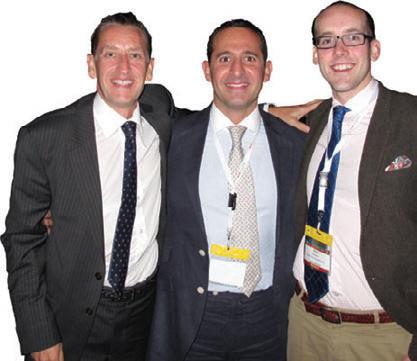
5 minute read
ONA History and Art Prize Essays
from ONA 88
ONA Essay Prizes 2012
For several years now the Association has set essay competitions for the school and we continue to be overwhelmed by the quality of the entries. Over the following pages, you’ll find the latest winning essays from Edwin Wood and Sam Mason-Jones.
Advertisement
History Essay Prizewinner Edwin Wood, Year 11, with President of the ONA, David Westwood (95-02).
Reflections on the Year 11 trip to the Battlefields in 2012
It is easy to look over the monumental figures of the Great War when scanning through textbooks: just under one million British casualties, two million children fatherless in Germany, a continuous array of figures. The scale of these numbers is too large for anybody to contemplate without witnessing, dotted across the French countryside, remnants of the war shown through the means of cemeteries or monuments.
When seeing a Commonwealth war grave, the glistening white of the headstones creates a sense of tranquility for those who sacrificed so much to rest finally in peace on the land which they fell. Many of those graves have, etched into the stone:
‘A SOLDIER OF THE GREAT WAR KNOWN UNTO GOD’
Questions instantly arise of, who was this person? Where was he from? What about his family? Sadly, many of these questions will never be answered, those graves will remain the silent reminder of the heroes who fell for their country.
Private Edwin Laidlow and Private Septimus Wood, both my relatives, are commemorated on the Menin Gate in the town of Ypres. These two men, within days of each other died in 1914, unknown to each other, would never have thought that their distant relative would be staring up at their names. Both Edwin and Septimus are the people behind the graves with no name, what does this do to someone learning about the war? Being able to make the experience personal not only brought the facts and figures more imaginable but it also made me think about what their story was.
Septimus, son of Septimus and Mary Anne Wood, of North Shields, who died aged 34 on 26th October 1914, had already fought in the Boer War. Looking through the War Diaries of his Border Regiment, a picture can be built of his final days. He had arrived on 5th October and had marched throughout Belgium for weeks before coming to Kruseik Hill. This was the platform for days of heavy German artillery, with small attacks
launched on the entrenched soldiers. It was through the night that the enemy advanced through the woods taking the front line of trenches. It is described as around 70 of the two companies’ remaining men retreated. This is almost certainly where Septimus died, on that day the casualties are described as ‘heavy’. Under ‘Other ranks: Killed: 25, Wounded: 65, Missing: 174.’ Septimus Wood lies within these numbers among many other helpless individuals.
Among the rows of graves, it is not just my relatives that lie there; it is the resting place of thousands of relatives. Their succeeding generations will be found in mainland Europe, Australasia, North America and here in Britain. It will not be the men who fell who keep us to remember them; it is those who have been left behind to pass the story on. It is our duty to never forget all those who fought and died for us, they shall not grow old, as we will not allow them to.
Edwin Wood
New York
It was Ezra Pound, in his essay collection Patria Mia, who declared that ‘No urban night is like the night in New York Squares after squares of flame, set up and cut into the aether. Here is our poetry, for we have pulled down the stars to our will.’ Though Hurricane Sandy closed shops and the subway, battered Queens and flooded Hoboken, it did not manage to douse the ‘flame’ of New York –the retention of its people’s steely resolve held by the lights which still shone from Times Square.
It was in an antediluvian Times Square that a certain unreal prevailed: you feel involved, at the heart of something; time slows down in a rapture of noise and neon. The coarse magic of a Manhattan night time is something to be held.
It was into the city of the unreal, Fitzgerald’s muse, Sinatra’s stomping ground, that twenty-three teenage art students emerged, tired-eyed, on a Friday morning in October. The sun-dappled streets of Chelsea, in the west of New York, were where the group was submerged and enthralled into its veins. Even away from the vivacity of its core, the city holds an immediacy; its sounds are alluring, its air infectious. Chelsea is charming, an agglomeration of grit and galleries, artistry and finesse, it feels like a secret –pregnant, undiscovered. The intimacy of the area embraces its appeal; galleries glare at each other from across roads, around corners –hidden away and secretive, each holds remarkable promise. The Chuck Close exhibit was exquisite; the artist had woven hyper-realist similarity (in portraits of Lou Reed, among others) out of textile and pencil, creating a highlight in the enclave of artistry that is Chelsea.
In the lungs of New York, the city holds another haven of calm air, a refuge of serenity juxtaposed against the commotion from which it protects. Central Park provides a refreshing, replenishing reminder of the natural from within the metropolis in which it is encased, a refrain that linked our visits to galleries like the Museum of Modern Art, the Metropolitan Museum and the Guggenheim. These visits were imposing; upon stepping in, we are faced with a glut of art; the atrium of the Met is hung lucidly with screen prints of Andy Warhol, and thinks nothing of it; the Guggenheim is laced with the work of Pablo Picasso; and neither seems to give a second thought or admittance of awe.
Perhaps this relaxed attitude toward the extraordinary is a reflection of the city itself, itself so in tune with the remarkable, the surprising, that which a stroll along Fifth Avenue confirms. It conveys an immediacy, which clings to the island, that strikes –as Thomas Wolfe asserted: ‘One belongs to New York instantly, one belongs to it as much in five minutes as in five years.’ Its colour is captivating, its people fierce, and like some low form of life it continues. Like the stars with which Pound creates an assimilation, it becomes clear that even in the very instantaneous, the flame of New York City is eternal.
Sam Mason-Jones
New York Art Trip Essay Prizewinner Sam Mason-Jones, U6, in New York outside the Luhring Augustine Gallery in Chelsea, October 2012 at the opening exhibition Neon by Glenn Ligon.





